
The principle that makes available to an embodied soul both gross and subtle (i.e. manifest and unmanifest) frequencies of higher or lower Gods and Deities in a shorter time is called Lord Datta or Shri Dattatreya. The very meaning of Datta is the ‘One who provides frequencies of Divine consciousness’. – (Pujya) Ms. Anjali Gadgil
Shri Dattatreya bestows His grace on man by giving speed to the journey of his ancestors to the next region and reducing his distress from ancestors. God gives man a chance to get liberated from the debt of ancestors through the ritual that gives speed to ancestors onward journey and through chanting the Name of Dattatreya.
One cannot get rid of the ancestors’ debt merely by remembering them off and on, displaying their photos in the house or publishing their photos in newspapers on their death anniversaries. It is only by chanting the Name of Dattatreya that the ancestors get speed to go on their onward journey in true sense. From this we can realise that it is imperative to worship the Deity to get liberated from the ancestors’ debt. This also reduces the debt of God on us. – Ms. Madhura Bhosale
A. The one who upholds the nobility of Varṇashramdharma (The system of four social classes and Ashrams [Stages of life]). (Details on this are provided in Sanatan’s Holy text ‘Varṇashramvyavastha’)
B. An ideal of Guru Principle and exponent of Yoga (According to Shanḍilyopanishad). Wellknown disciples of Lord Datta include Alark, Prahlad, Yadu, Sahasrārjun, Parshurām etc.
C. Teacher of Tantrashastra (According to Tripurasundarirahasya)
D. With behaviour like that of the evolved (like Shrikrushṇa), one freed from the bondage of religious restrictions (Markanḍeyapuraṇ).
E. One who lives as He wishes and is readily accessible (to those who remember Him).
F. Lord Datta and Lord Shiva bestow detachment (other Deities bestow everything but detachment).
G. Avadhut
H. A symbol of harmony
1. Shaiva (A sect that worships Shiva) and Vaishṇav (A sect that worships Shrīvishṇu) : Both these sects feel close to Dattatreya because of His form as a Guru (Spiritual guide).
I. One who liberates from the problems caused by deceased ancestors. Read More
J. Protection from negative energies
K. Daily rituals
1. To reside at : Peak of Meru Mountain
2. To bathe at : Varanasi (on the banks of River Ganga)
3. For āchaman (Sipping water) : Kurukshetra
4. To apply sandalwood paste : Prayag (Variation – to apply tilak [Saffron] to the forehead : Pandharpur)
5. For morning sandhya (Rituals of devotion performed by Brāhmaṇs) : Kedar
6. To partake of Vibhuti (Holy ash) : Kedar
7. To meditate : Gandharvapattan (Variation – Yoga : Girnar, Saurashtra, Gujarat)
8. For afternoon bhiksha (Alms) : Kolhapur, Maharashtra
9. For lunch : Panchaleshwar, District Beed, Marathwada, Maharashtra in the bed of River Godavari
10. To chew tambul (Roll of betel leaves) : Rakshasbhuvan, District Beed, Marathwada, Maharashtra
11. To relax : Raivat Mountain
12. For evening sandhyā : Ocean to the west of Bharat
13. To hear Puraṇs : Naranarayan Ashram (Variation – to hear discourses and kīrtans [Narration of the glory of God through stories, punctuated with devotional songs] : Naimisharanya, Bihar)
14. To sleep : Mahurgad (Variation – Sahyaparvat, Nanded, Maharashtra)
Of these, 2, 8 and 14 are renowned seats of Lord Datta.
Reference: ‘Datta’, published by Sanatan Sanstha

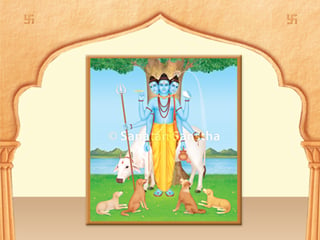
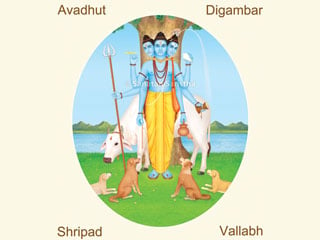 Names of Shri Datta and their meanings
Names of Shri Datta and their meanings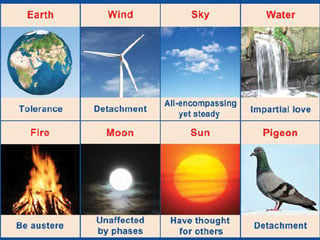 24 Gurus of Dattatreya - Gurus and subordinate Gurus
24 Gurus of Dattatreya - Gurus and subordinate Gurus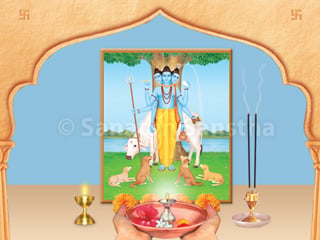 Worship of Shri Datta and Dattatreya puja
Worship of Shri Datta and Dattatreya puja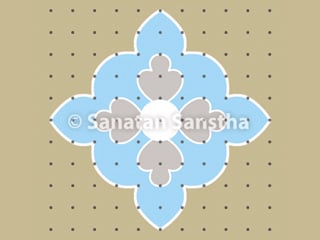 Rangoli designs associated with Shri Datta Principle
Rangoli designs associated with Shri Datta Principle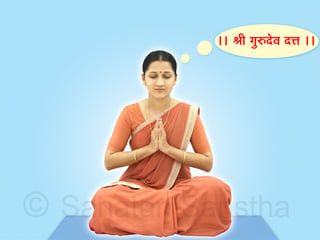 What is the significance of chanting Shri Gurudev Datta?
What is the significance of chanting Shri Gurudev Datta?